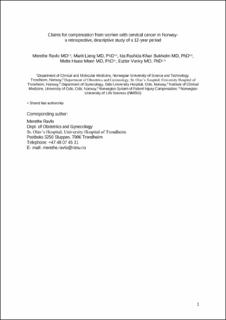Claims for compensation from women with cervical cancer in Norway-A retrospective, descriptive study of a 12-year period
Peer reviewed, Journal article
Accepted version
Permanent lenke
https://hdl.handle.net/11250/2779792Utgivelsesdato
2020Metadata
Vis full innførselSamlinger
Originalversjon
Acta Obstetricia et Gynecologica Scandinavica. 2020, 99 (11), 1546-1553. 10.1111/aogs.13930Sammendrag
Introduction: In Norway, all patient-reported claims for compensation are evaluated by The Norwegian System of Patient Injury Compensation (NPE). The number of claims from women with cervical cancer is rising, and the approval rate is high. Our aim was to study claims for compensation from women with cervical cancer to identify the type of failures, when, during the time-course of treatment, the medical failures occurred, and the consequences of the failures. Material and methods: A retrospective, descriptive study of claims for compensation to NPE from cervical cancer patients during a 12-year period, from 2007 through 2018. We used anonymized medical expert statements and summaries of NPE cases. Results: In all, 161 women claimed compensation for alleged medical failure related to cervical cancer. Compensation was approved for 100 (62%) women. Mean age at the time of alleged failure was 37.5 years (SD ±9.9). The main reasons why women sought medical attention were routine cervical screening (56%), or vaginal bleeding or discharge (30%). In approved cases, incorrect evaluation of cytology and histology was the cause of most failures (72%). Mean delay of cervical cancer diagnosis for approved cases was 28 months (SD ±22). Treatment not in accordance with guidelines was the cause of failure in 2% of the cases, and failure during follow up was the cause of failure in 12%. Consequences of the failures were as follows: worsening of cancer prognosis (89%), treatment-induced adverse effects, such as loss of fertility (43%) and/or loss of ovarian function in premenopausal women (50%), and permanent injury after chemo-radiation (27%). Seven women (7%) died, most probably as a consequence of the failure. Conclusions: The main cause of medical failure in women with cervical cancer was incorrect pathological diagnosis. The main consequences of failures were worsening of cancer prognosis and treatment-induced adverse effects. Increased focus on the quality of pathological examinations, and better routines in all parts of the cervical examinations might improve patient safety for women in risk of cervical cancer.
